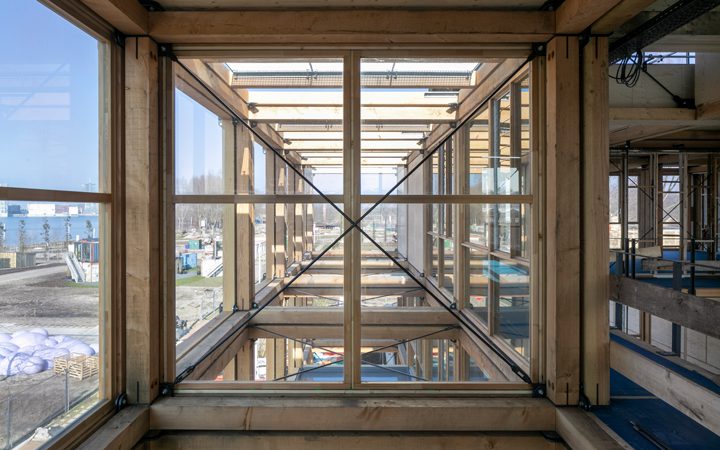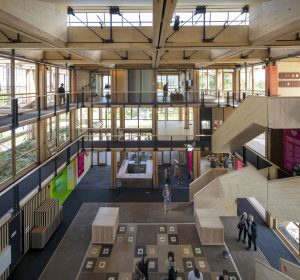Oosterhoff helps build industrial and circular government pavilion
16 August 2022

ALMERE, 12 April 2022 – With The Natural Pavilion, Oosterhoff and a consortium of almost 20 Dutch companies are showing that it is already possible to build houses, schools and offices on an industrial scale that is completely circular, bio-based, energy-neutral and in close harmony with nature. From Oosterhoff, ABT, Adviesbureau Lüning, bbn adviseurs and HE adviseurs collaborated on this innovative project. And what’s more, at a high pace never before realised. The State Pavilion is part of the Dutch Innovation Experience at the Floriade Expo 2022 in Almere and will open its doors on 14 April.
The Dutch construction sector faces a huge challenge. Not only is the housing shortage high, but CO2 and nitrogen emissions combined with tightened legislation and environmental regulations are causing great complexity in project development. Other social challenges include energy transition and the increasing exclusion of the middle class from the owner-occupied housing market. Also, the industry has the ambition to be fully circular by 2050.
Oosterhoff brought expertise in areas such as structural and geotechnical engineering, fire safety, parametric design , an innovative smart water buffer and a natural indoor climate. The aim was to control the climate in the building based on natural ventilation. The climate in the building is a logical consequence of the weather conditions outside. Only the positive aspects of this are experienced inside, while the negative aspects are kept out by the building envelope.
Climate agreement in practice
 The pavilion is built almost entirely of bio-based materials and is literally an accumulation of innovations For instance, the pavilion shows the possibilities of using green in the living and working environment (even in stacked buildings up to 80 metres high), new forms of rainwater collection, sustainable foundation solutions, optimal use of natural daylight, natural ventilation and minimal energy consumption. The design shows the integration of architecture, structures, building physics and sustainability aspects and has been created using new (digital) design techniques and in a previously unprecedented way of construction collaboration. The pavilion was designed and built within six months. The combination of the modular HoutKern construction method, the industrialised construction process and bio-based materialisation makes The Natural Pavilion the epitome of circular construction.
The pavilion is built almost entirely of bio-based materials and is literally an accumulation of innovations For instance, the pavilion shows the possibilities of using green in the living and working environment (even in stacked buildings up to 80 metres high), new forms of rainwater collection, sustainable foundation solutions, optimal use of natural daylight, natural ventilation and minimal energy consumption. The design shows the integration of architecture, structures, building physics and sustainability aspects and has been created using new (digital) design techniques and in a previously unprecedented way of construction collaboration. The pavilion was designed and built within six months. The combination of the modular HoutKern construction method, the industrialised construction process and bio-based materialisation makes The Natural Pavilion the epitome of circular construction.
"This pavilion is not only built sustainably. It also shows at what speed we can build a building together. For Oosterhoff, this is the first step towards a future with many more projects like this," says Maaike van der Windt, COO at Oosterhoff.
More than 95% bio-based
To realise The Natural Pavilion, the construction consortium had to meet very strict conditions in the tender. The very first plans for the National Pavilion therefore already assumed 100% bio-based construction; innovative and scalable solutions for the entire market; a circular construction process with an eye for biodiversity; a zero-emission construction site; a parametric design; sustainability performance of the highest level and the requirement that the entire business case would be circular. Gerben Kuipers, the founder of the Noordereng Group, initiator and developer of The Natural Pavilion, says: "The uniquely developed HoutKern Construction Method ensures huge savings in CO2 emissions. The pavilion is completely modularly constructed from wooden beams and columns held together only at the corners by recycled steel nodes." Almost all other building products used to construct The Natural Pavilion are also made of bio-based materials. For instance, the interior walls are made of (residual) materials from agriculture and horticulture: straw, flax, pepper stalks and a wood fibre textile finish.
The building has been designed nature-inclusively, in line with the Floriade theme Growing Green Cities. Outside and against the façade, native plantings grow in line with the flora and  fauna present in Flevoland. The plants purify water and air, facilitate biodiversity, retain rainwater and store nitrogen and CO2.
fauna present in Flevoland. The plants purify water and air, facilitate biodiversity, retain rainwater and store nitrogen and CO2.
After the Floriade, the pavilion will be dismantled to serve as an exhibition space and film theatre in various Dutch nature reserves for three years. The pavilion thus serves as a textbook example of circular and modular construction. After 2025, parts of the State Pavilion will be used for the new building of the FlevoCampus, the knowledge institute that helps create solutions for urban food issues.
Read more about The Natural Pavilion at www.thenaturalpavilion.eu.
Visit our pavilion at Floriade Expo 2022 Almere from 14 April to 9 October 2022.
Photography: Daria Scagliola & Stijn Brakkee.